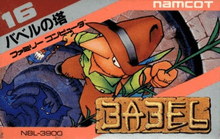Tower of Babel (1986 video game)
Tower of Babel (バベルの塔, Babel no Tō), is a platformer/puzzle hybrid video game. It was first released for the Nintendo Family Computer by Namco under the "Namcot" brand name[1] in Japan on July 18, 1986 as the 16th installment of the "Namcot Family Computer Game Series". Most recently the game was distributed on the Wii U Virtual Console in 2014.
| Tower of Babel | |
|---|---|
 Famicom cover of Tower of Babel. | |
| Developer(s) | Namco |
| Publisher(s) | Namco |
| Programmer(s) | Takashi Fukawa |
| Composer(s) | Norio Nakagata |
| Platform(s) | Family Computer |
| Release |
|
| Genre(s) | Platform, puzzle |
| Mode(s) | Single-player |
The game's goal is to solve the puzzle of each of the 64 levels of the ancient Tower of Babel and reach the top of the tower. The player controls the protagonist, Indiana Borgnine, who must avoid enemies while rearranging L-shaped blocks in order to reach each level's exit.[2]
Development was done by Namco, and the project was planned by Hiroshima Nagashima, who had worked on the company's arcade game Sky Kid (1985), the music was by Norio Nakagata, and the character design was by Hiroshi Fuji.
Gameplay
The player controls Indiana Borgnine through 64 levels, using L-shaped blocks and vines in order to reach the exit of each level. On some levels, the exit is blocked by a mask, and there are crystal balls throughout the level. If all of the crystal balls on a level are collected, then the mask covering that level's exit will disappear, and the exit will no longer be blocked. When the exit of a level is reached, a screen is displayed showing the score achieved on that level before the character moves on to the next level. In the top right corner of the screen there is a power count. Lifting an L-shaped block causes the power count to go down by 1. Items will occasionally spawn while the player goes through the tower. The items are:
- Pots (100 points and add 1 to power count)
- Crowns (200 points)
- Jewels (400 points and invincibility. Enemies killed while invincible are worth 1000 points)
- Lamps (1000 points and enable Indiana Borgnine to pass through L-shaped blocks)
- Stars (Increase Indiana Borgnine's speed)
Plot
Archaeologist and explorer Indiana Borgnine (インディー・ボーグナイン) is in search of the fabled Hanging Gardens of Babylon. After reading some lost scriptures, he determines that the only way to see them is to travel to the very top of the 64-story Tower of Babel from the Book of Genesis of the Old Testament. Upon reaching the Tower, he discovers that the only way to access the floors above him are to solve some challenging puzzles involving loose L-shaped blocks that he finds throughout the Tower. To his great surprise, the blocks are capable of balancing very well on top of one another, in order to form staircases.
References
- Smith, David. Feature: What's in a Name Archived November 4, 2012, at the Wayback Machine. 1Up.com. June 13, 2005.
- "Babel no Tō (1986)". MobyGames. Retrieved January 29, 2020.